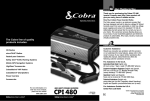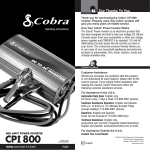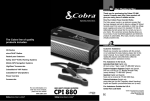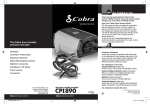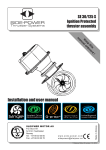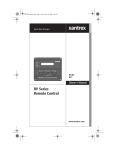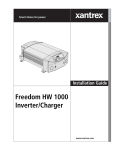Download Xantrex Technology 500 Power Supply User Manual
Transcript
www.xantrex.com [email protected] 1-604-422-8595 1-800-670-0707 (toll free in North America) 1-604-420-1591 1-800-994-7828 (toll free in North America) Xantrex Inverter 500 Owner’s Guide 445-0140-01-01 Printed in China Web: Email: Phone: Phone: Fax: Fax: About Xantrex Xantrex Technology Inc. is a world-leading supplier of advanced power electronics and controls with products from 50 watt mobile units to 1 MW utility-scale systems for wind, solar, batteries, fuel cells, microturbines, and backup power applications in both grid-connected and stand-alone systems. Xantrex products include inverters, battery chargers, programmable power supplies, and variable speed drives that convert, supply, control, clean, and distribute electrical power. Trademarks Xantrex is a registered trademark of Xantrex Technology Inc. © 2001 Xantrex International. All rights reserved. Notice of Copyright Xantrex Inverter 500 Owner’s Guide © September 2001 Xantrex International. Disclaimer Unless specifically agreed to in writing, Xantrex Technology Inc., (“Xantrex”): (a) Makes no warranty as to the accuracy, sufficiency, or suitability of any technical or other information provided in its manuals or other documentation. (b) Assumes no responsibility or liability for loss or damage, whether direct, indirect, consequential, or incidental, which might arise out of the use of such information. The use of any such information will be entirely at the user’s risk.While every precaution has been taken to ensure the accuracy of the contents of this guide, Xantrex International assumes no responsibility for errors or omissions. Note as well that specifications and product functionality may change without notice. Date and Revision October 2001, Revision 3 Part Number 445-0140-01-01 Contact Information Web: Email: Phone: Phone: Fax: Fax: www.xantrex.com [email protected] 1-604-422-8595 1-800-670-0707 (toll free in North America) 1-604-420-1591 1-800-994-7828 (toll free in North America) Contents 1. Introduction . . . . . . . . . . . . . . . . . . . . . . . . . . . . . . . . . 1 2. Important Safety Information . . . . . . . . . . . . . . . . . . 2 Warnings and Cautions . . . . . . . . . . . . . . . . . . . . . . . . 2 3. Xantrex 500 Inverter Features . . . . . . . . . . . . . . . . . . 5 AC Outlets . . . . . . . . . . . . . . . . . . . . . . . . . . . . . . . . . 7 4. Connecting the 500 Inverter . . . . . . . . . . . . . . . . . . . . 8 Choosing a Location . . . . . . . . . . . . . . . . . . . . . . . . . . 8 Fastening the Inverter to a Mounting Surface . . . . . . . 8 Connecting the 500 Inverter to DC Power . . . . . . . . . 9 Using the Battery Clip Wire Assembly . . . . . . . . . . 11 Hardwiring the Inverter to the Battery . . . . . . . . . . 13 Disconnecting the Battery . . . . . . . . . . . . . . . . . . . . . 15 Replacing the In-Line Fuse . . . . . . . . . . . . . . . . . . . . 15 5. Operating the 500 Inverter . . . . . . . . . . . . . . . . . . . . 16 Operating Statuses . . . . . . . . . . . . . . . . . . . . . . . . . . 16 Interference With Electronic Equipment . . . . . . . . . 18 6. Battery Operating Time . . . . . . . . . . . . . . . . . . . . . . 19 7. Troubleshooting . . . . . . . . . . . . . . . . . . . . . . . . . . . . . 20 8. Warranty Information . . . . . . . . . . . . . . . . . . . . . . . 23 Returning a Product . . . . . . . . . . . . . . . . . . . . . . . . . 24 To Place of Purchase . . . . . . . . . . . . . . . . . . . . . . . . 24 To Xantrex . . . . . . . . . . . . . . . . . . . . . . . . . . . . . . . . 24 Out-of-Warranty Service . . . . . . . . . . . . . . . . . . . . . 25 9. Specifications . . . . . . . . . . . . . . . . . . . . . . . . . . . . . . . 27 Electrical . . . . . . . . . . . . . . . . . . . . . . . . . . . . . . . . . . 27 Physical . . . . . . . . . . . . . . . . . . . . . . . . . . . . . . . . . . . 28 Regulatory . . . . . . . . . . . . . . . . . . . . . . . . . . . . . . . . . 28 i ii 1 Introduction Thank you for purchasing the Xantrex 500 Inverter. The 500 Inverter is part of a family of advanced, highperformance power inverters from Xantrex, the leader in the field of high-frequency inverter design. Connected directly to a 12 volt battery, the 500 Inverter efficiently and reliably powers a wide variety of household AC products, such as TVs and VCRs, laptop computers, camcorder and cell phone chargers, compact fluorescent lights, soldering irons, and small power tools. The 500 Inverter uses reliable solid state power electronics for years of safe, trouble-free operation and includes automatic safety monitoring circuitry to protect it from inadvertent overload conditions. Read this guide before connecting or using the 500 Inverter, and save it for future reference. The main topics in the guide are: • Safety information (page 2) • 500 Inverter features (page 5) • Instructions for connecting the inverter (page 9) • Operating guidelines (page 16) • Troubleshooting information (page 20) • Warranty and service information (page 23) • Specifications (page 27) 2 Important Safety Information If the 500 Inverter is connected or used incorrectly, hazardous conditions may be created. Read and save this safety information, and pay special attention to all Caution and Warning statements in the guide and on the inverter itself. Warnings and Cautions are indicated by this symbol: • • Warning statements identify conditions that could result in personal injury or loss of life. Caution statements identify conditions or practices that could result in damage to the 500 Inverter or other equipment. Warnings and Cautions Warning! Shock hazard. The 500 Inverter generates the same potentially lethal AC power as a household wall outlet. Do not insert foreign objects in the inverter’s AC outlet or any other openings in the inverter. Do not open the inverter. Have a qualified individual complete any service work. Warning! Shock hazard. Do not expose the 500 Inverter to water, rain, snow, or spray. 2 Warning! Risk of fire or explosion. The 500 Inverter contains components that tend to produce arcs or sparks. To prevent fire or explosion, do not install the inverter in compartments containing batteries or flammable materials or in locations that require ignitionprotected equipment. Warning! Fire hazard. To reduce the risk of fire, do not cover or obstruct the ventilation openings. Do not install the 500 Inverter in a zero-clearance compartment. Overheating may result. Warning! Shock and fire hazard. During installation route all cable/wiring away from sharp edges and hot surfaces of the engine compartment or vehicle. Caution! Risk of damage to equipment. The 500 Inverter is designed to be directly connected to standard electrical and electronic equipment in the manner described in this guide. Do not connect it to household or RV AC distribution wiring. Do not connect it to any AC load circuit in which the neutral conductor is connected to ground (earth) or to the negative of the DC (battery) source. 3 Caution! Risk of damage to the 500 Inverter. Reverse battery polarity (negative connected to positive; positive connected to negative) will damage the 500 Inverter, and it will require servicing. Damage caused by reverse polarity is not covered by your warranty. Caution! Risk of damage to rechargeable appliances. The output of the 500 Inverter is non-sinusoidal. Certain battery chargers can be damaged if they are connected to the 500 Inverter. Two particular types of equipment are prone to this problem: • Small battery-operated appliances such as rechargeable flashlights, shavers, and night lights that can be plugged directly into an AC receptacle to recharge. • Certain battery chargers for battery packs used in hand power tools. These chargers have a warning label stating that dangerous voltages are present at the charger battery terminals. Do not use the 500 Inverter with the type of appliances just described. Caution! Risk of damage due to high temperatures. Do not use the 500 Inverter in temperatures over 40° C (105° F). Overheating may result. 4 3 Xantrex 500 Inverter Features This section describes the main features of the 500 Inverter. Figure 1 shows the inverter’s AC panel. ① ② ③ ④ ➄ Figure 1 AC Panel on the 500 Inverter (European AC Outlet) ➀ AC Outlet An AC outlet is located on one end of the inverter. It allows you to plug in a 230 volt AC product with a power consumption of 500 watts or less when the inverter is connected to a 12 volt battery. The AC outlet on your inverter may be different from the one shown here. For all available outlets, see Figure 2, Figure 3, and Figure 4, on page 7. ➁ On/Standby Switch The two positions on the On/Standby switch are: 5 = Standby and = On. When the inverter is connected to a DC power source and the On/Standby switch is on, AC power is available at the outlet. ➂ Power Light The green PWR light is on all the time when the On/Standby switch is on. light indicates that the ➃ Fault Light The red inverter has shut down because of low or high battery voltage, AC overload, or excessively high temperatures. ➄ Mounting Flanges Mounting flanges on the AC and DC ends allow you to mount the inverter permanently. For additional information, see “Fastening the Inverter to a Mounting Surface” on page 8. Audible Alarm An audible alarm warns you of a high temperature shutdown or of an impending low voltage shutdown. Fan The fan (see Figure 5) turns on when an AC load of 100 watts or higher is plugged in. 6 AC Outlets Depending on your geographic location, your 500 Inverter will have one of the following AC outlets. Figure 2 European AC Outlet Figure 4 Australian and New Zealand AC Outlet 7 Figure 3 British AC Outlet 4 Connecting the 500 Inverter This section explains how to connect the 500 Inverter. Choosing a Location For the best performance, choose a location that is: • Dry Do not expose the inverter to water drip or spray. • Cool Operate the inverter in ambient temperatures between 0° C and 40° C (32° F and 100° F). Keep it away from heating vents and direct sunlight. • Well ventilated For proper cooling, allow at least 5 cm (2 in.) of clearance around the inverter. • Clean and free of dust and dirt Choose a location that is free of any debris that could get into the inverter. • Protected from battery gases Do not mount the inverter where it will be exposed to battery gases. These are very corrosive and will damage the inverter. Fastening the Inverter to a Mounting Surface For temporary or portable use, place the inverter on a flat surface like a table or the floor of your vehicle. For a permanent installation, use four screws to attach the inverter’s mounting flanges to an appropriate surface. Note: Local and national electrical codes that apply to your installation may require that you permanently mount the inverter if you make permanent electrical connections and may disallow permanent mounting if you make a temporary electrical connection. 8 Connecting the 500 Inverter to DC Power Warning! Corrosive materials and energy hazard. To reduce the risk of irritation and burns, wear protective eyewear and clothing when you work with batteries. Take special care to ensure that metal tools or personal objects like rings or watches do not contact the battery terminals. Caution! Risk of damage to the 500 Inverter. The 500 Inverter must only be operated with a nominal 12 volt battery. The inverter will not operate with a lower voltage battery. A higher voltage battery will damage the inverter. Caution! Damage to the 500 Inverter. Reversing the positive and negative battery cables will damage the inverter and will void your warranty. When you connect the inverter to the battery, double check the connections. The red wire must be connected to the red (+) terminal on the inverter and the positive (+) terminal on the battery. The black wire must be connected to the black (–) terminal on the inverter and the negative (–) terminal on the battery. 9 You can make a temporary or a permanent connection between the inverter and the 12 volt DC power source. • Use the battery clip wire assembly to make a temporary connection (page 11). • Hardwire the inverter to the battery to make a permanent connection (page 13). Refer to Figure 5 and Figure 6 when you connect the inverter. ① ② ③ Figure 5 DC Panel on the 500 Inverter ① Fan ② Red (positive +) terminal ③ Black (negative – ) terminal 10 Using the Battery Clip Wire Assembly Warning! Corrosive materials and energy hazard. To reduce the risk of irritation and burns, wear protective eyewear and clothing when you work with batteries. Take special care to ensure that metal tools or personal objects like rings or watches do not contact the battery terminals. Caution! Risk of damage to the 500 Inverter. Reversing the positive and negative battery cables will damage the inverter and void your warranty. When you connect the inverter to the battery, double check the connections. The red wire must be connected to the red (+) terminal on the inverter and the positive (+) terminal on the battery. The black wire must be connected to the black (–) terminal on the inverter and the negative (–) terminal on the battery. Caution! Fire hazard. The wires in most 12 volt sockets or power outlets are not large enough for loads greater than 150 watts: they will overheat and present a fire hazard. For loads greater than 150 watts, connect the inverter directly to the battery and use appropriately sized wires like those in the battery clip wire assembly provided with the inverter. 11 To connect the inverter to a 12 volt battery using the battery clip wire assembly: 1. Remove the nuts from the DC terminals on the inverter. 2. Place the red ring connector on the red (positive +) DC terminal, and then screw the red nut on until it is snug. Do not over tighten. 3. Attach the red clip to the red (positive +) battery terminal. 4. Attach the black clip to the black (negative –) battery terminal. 5. Place the black ring connector on the black (negative –) DC terminal, and then screw the black nut on until it is snug. Do not over tighten. Note: A spark may occur when you make this connection. This is normal. 6. Check that both clips are securely connected to the battery terminals. A loose connection will cause excessive voltage drop and may cause the cables to overheat. This could result in equipment damage or fire. 7. Turn on the On/Standby switch. The green PWR light comes on, and AC power is available at the outlet. 12 Hardwiring the Inverter to the Battery A hardwired installation is illustrated in Figure 6. Warning! Shock and fire hazard. Use a qualified installer to perform a hardwired installation. ➄ – ① ④ ➂ + ② Figure 6 Hardwiring the 500 Inverter to a 12 Volt Battery ① 500 Inverter ② 8.4mm2 (8 AWG) red wire from the positive inverter terminal to the positive battery terminal (via the fuse and switch) ➂ 80 amp automotive fuse ④ 12 volt, 80 amp disconnect switch ➄ 12 volt battery 8.4mm2 (8 AWG) black wire from the negative inverter terminal to the negative battery terminal. To hardwire the inverter to a 12 volt battery: 1. Cut the clips off the cable clip wire assembly. 13 2. 3. 4. 5. Using 8.4mm2 (8 AWG) wire or heavier, extend the power cord if you need to, to a maximum total length of 2 meters (6.5 feet) including the existing 500 Inverter power cord length. Solder all connections and make sure they are properly insulated by using electrical tape or heat shrinkable tubing. Install an 80 amp automotive fuse and a switch rated at 80 amps in the positive (red) wire, close to the end that will attach to the battery. See Figure 6. The switch lets you disconnect the DC power if you need to replace the in-line fuse. Solder and insulate the connections as detailed in Step 2 above. Turn off the in-line switch. Solder or crimp heavy-duty terminals to the battery end of the positive and negative wires. Use terminals that mate properly with the battery terminals or existing battery cable clamps. Warning! Damage to the 500 Inverter. Reversing the positive and negative battery cables will damage the inverter and will void your warranty. Before connecting the inverter to the battery, double check the connections: the red wire must be connected to the red terminal on the inverter and the positive (+) terminal on the battery; the black wire must be connected to the black terminal on the inverter and the negative (–) terminal on the battery. 14 5 Operating the 500 Inverter This section describes normal operation as well as several problems that could occur when you use the inverter. If you have a problem, see “Troubleshooting” on page 20. Operating Statuses • • • 16 Normal Operation When you connect the inverter to your vehicle’s 12 volt source and turn on the On/ Standby switch, the green PWR light comes on, and AC power is available at the outlet. The inverter shuts down automatically in response to low battery voltage, high battery voltage, AC overload, overheating, or a short in the AC output. Low Battery Voltage Alarm and Shutdown As the battery discharges, its voltage decreases. When the inverter senses that the voltage at its DC input has dropped to 10.7 volts, it sounds an alarm. This gives you time to shut down computers or other sensitive devices. If you ignore the alarm, and the DC input drops to 10.0 volts, the inverter shuts down the AC load being operated. The PWR light stays on, the alarm stays on, and the light comes on as well. The low battery voltage shutdown feature is designed to save the battery from excessive discharge, which can prevent you from starting your vehicle, or more seriously, damage the battery. Possible shutdown when the vehicle’s engine is started The 500 Inverter will operate while your vehicle’s engine is running, but the normal voltage drop • • • 17 that occurs when the engine starts may trigger a low voltage shutdown. AC Overload Shutdown If you connect an AC load rated higher than 500 watts or 2.2 amps or that draws excessive surge power, the 500 Inverter shuts down. light comes on The PWR light stays on, and the to indicate that the inverter is overloaded. Note: High startup surge requirements The power, or “wattage” rating of an AC load is the average amount of power it uses. When they are first turned on, many AC loads consume more power than their continuous power rating. TVs, monitors, and electric motors are examples of loads that have high surge requirements at start up. Although the 500 Inverter can supply momentary surge power to 1000 watts, some products rated less than 500 watts can exceed its surge capabilities and trigger the AC overload shutdown feature. (See page 20 for troubleshooting procedures.) High Battery Voltage Shutdown If a defective battery charging system causes the battery voltage to rise to dangerously high levels, the inverter shuts down automatically. The PWR light stays on, and the light comes on. High Temperature Shutdown If the inverter exceeds its safe operating temperature because of insufficient ventilation or a high-temperature environment, it sounds an alarm and shuts down automatically. The PWR light stays on, and the light comes on. When the inverter has cooled sufficiently, it restarts automatically. Interference With Electronic Equipment Most AC products operate with the 500 Inverter as they would with household AC power with the following exceptions. Buzzing Sound Some inexpensive stereo systems and “boom boxes” have inadequate internal power supply filtering and buzz slightly when powered by the 500 Inverter. The best solution is to have an audio system with a good quality filter. Television Interference The 500 Inverter is shielded to minimize its interference with TV signals. If TV signals are weak, you may see the interference in the form of lines scrolling across the screen. Try one of these suggestions to minimize or eliminate the problem: • Use an extension cord to increase the distance between the inverter and the TV, antenna, and cables. • Adjust the orientation of the inverter, TV, antenna, and cables. • Maximize TV signal strength by using a better antenna, and use shielded antenna cable where possible. • Try a different TV. Different models vary considerably in their susceptibility to interference. 18 6 Battery Operating Time The battery operating time of the 500 Inverter depends on the charge level of the battery, battery capacity, and the amount of power drawn by the particular AC load. With a typical vehicle battery and a 300 watt load, you can expect one or more hours of operating time. To preserve the battery: • Do not allow your vehicle battery to become deeply discharged. A vehicle battery (starting battery) is not designed to be deeply discharged, and repeated deep discharge/charge cycles will shorten its life. When you use a vehicle battery as a power source, start the vehicle every hour or two and run it until you have partially recharged the battery. • Do not leave the 500 Inverter on for more than a week if you do not have an AC load connected to it. The inverter draws less than 0.3 amps with the On/ Standby switch on and no load connected, but that will eventually discharge the battery. • When the 500 Inverter is not in use, do one of the following: • Disconnect the DC cable clips from the battery. • Turn off the in-line switch if the inverter is hardwired to the battery. 19 7 Troubleshooting Warning! Shock Hazard. Do not open the inverter or attempt to service it yourself. Refer all service to qualified personnel. This section describes problems you could encounter, as well as symptoms, possible causes, and various remedies. The AC load will not operate; red light is on. Symptom An AC load is plugged in or turned on, operates for one to ten seconds, and then shuts down. Possible cause Suggested remedy The AC load is rated at more than 500 watts; an overload shutdown has occurred. Use an AC load with a power rating less than 500 watts (2.2 amps). The AC load is rated at less than 500 watts, but a high starting surge has caused an overload shutdown. The AC load exceeds the inverter’s surge capability. Use a load with a starting surge power within its capability. Symptom The AC load does not operate. The light comes on when the inverter is turned on or when the AC load is turned on or plugged in. The alarm may sound. Possible cause Suggested remedy The battery is discharged. Recharge the battery. The battery voltage is excessive. Check the charging system. 20 Symptom The AC load runs for more than one minute, the alarm sounds, and the light comes on. The inverter is warm or hot to touch. The alarm may sound. Possible cause Suggested remedy Poor ventilation or a hightemperature environment has caused the inverter to overheat. Ensure that ventilation is not restricted around the inverter. The inverter will turn on again automatically when it has cooled sufficiently. The AC load will not operate; no inverter lights are on. Symptom The inverter has been connected to the 12 volt battery and the battery is charged, but the inverter does not work. Possible cause Suggested remedy The inverter could have been connected with reverse DC input polarity. The inverter has probably been damaged. Have it repaired. Damage caused by reverse polarity is not covered by the warranty. Instructions for returning the inverter are on page 25. 21 Measured inverter output voltage is too low. Symptom The AC voltmeter reading is 5 to 15 volts too low. Possible cause Suggested remedy A standard “average-reading” AC voltmeter has been used to measure output voltage. For accuracy, the 500 Inverter modified sine wave output needs to be measured with a “true RMS” voltmeter, like a Fluke 87 series multimeter. The battery voltage is too low. Recharge the battery. Battery operating time is less than expected. Symptom The inverter runs for a while, and then the light comes on. The inverter is cool or warm to touch. Possible cause Suggested remedy The battery is old or defective. Replace the battery. The battery is not being charged Have a qualified technician properly. check the vehicle’s electrical system. 22 8 Warranty Information What Does This Warranty Cover? Xantrex manufactures its products from parts and components that are new or equivalent to new, in accordance with industry standard practices. This warranty covers any defects in workmanship or materials. How Long Does The Coverage Last? This warranty lasts for two (2) years from the date of purchase. Implied warranties of merchantability and fitness for a particular purpose are limited to two (2) years from the date of purchase. Some jurisdictions do not allow limitations on how long an implied warranty lasts, so the above limitation may not apply to you. What Does This Warranty Not Cover? This warranty will not apply where the product has been misused, neglected, improperly installed, physically damaged or altered, either internally or externally, or damaged from improper use or use in an unsuitable environment. Xantrex does not warrant uninterrupted operations of its products. Xantrex shall not be liable for damages, whether direct, incidental, special, or consequential, or economic loss even though caused by the negligence or fault of Xantrex. Some jurisdictions do not allow the exclusion or limitation of incidental or consequential damages, so the above limitation or exclusion may not apply to you. What Will Xantrex Do? At its option, Xantrex will repair or replace the defective product free of charge. Xantrex will, also at its option, use new and/or reconditioned parts made by various manufacturers in performing warranty repair and 23 building replacement products. If Xantrex repairs or replaces a product, its warranty term is not extended. Xantrex owns all parts removed from repaired products. Service During Warranty In order to qualify for the warranty, dated proof of purchase must be provided and the product must not be disassembled or modified without prior authorization by Xantrex. If your product requires warranty service, please return it to the place of purchase along with a copy of your dated proof of purchase. If you are unable to contact your merchant, or the merchant is unable to provide service, contact Xantrex directly: Phone: 1-604-422-8595 Phone: 1-800-670-0707 (toll free in North America) Fax: 1-604-420-1591 Fax: 1-800-994-7828 (toll free in North America) Email: [email protected] Returning a Product You can return a product to the place of purchase or to Xantrex. To Place of Purchase If your product requires service, return it to the place of purchase along with a copy of your dated proof of purchase. To Xantrex If you are unable to contact your merchant, or the merchant is unable to provide service, contact Xantrex directly. 24 You must obtain a Return Material Authorization (RMA) number from Xantrex before returning a product directly to Xantrex. Do not return a product to Xantrex without first obtaining an RMA number. When you contact Xantrex to obtain service, be prepared to supply the serial number of your product and its date of purchase as well as information about the installation or use of the inverter. If you are returning an inverter directly to Xantrex: 1. Obtain an RMA number and a shipping address from Xantrex. Product(s) returned without an RMA number or shipped collect, will be refused. 2. Package the inverter safely, preferably using the original packing materials. Include the RMA number, a copy of your dated proof of purchase, a return address where the repaired inverter can be shipped, a contact telephone number, and a brief description of the problem. 3. Ship the inverter to the address provided in Step 1, freight prepaid. Obtaining proof of delivery is recommended. How Other Laws Apply: This warranty gives you specific legal rights, and you may also have other rights which vary from jurisdiction to jurisdiction. Out-of-Warranty Service If the warranty period for your 500 Inverter has expired, if the inverter was damaged due to misuse or incorrect installation, if other conditions of the warranty have not been met, or if no dated proof of purchase is available, your inverter may be serviced or replaced for a flat fee. 25 To return your 500 Inverter for out-of-warranty service, contact Xantrex customer service for a Return Material Authorization (RMA) number, and follow the other steps outlined in “To Xantrex” on page 24. Options for payment, such as credit card or money order, will be explained by the customer service representative. In cases where the minimum flat fee does not apply, as with incomplete inverters or inverters with excessive damage, an additional fee will be charged. If applicable, you will be contacted by customer service once your inverter has been received. 26 9 Specifications Specifications may change without notice. Electrical AC receptacles 1 AC output voltage 230 volts AC RMS ± 5% AC output frequency 50 ± 3 Hz AC output waveform Modified Sine Wave Maximum continuous AC output power 500 watts Maximum AC output surge power 1000 watts DC input voltage range 10–15 volts DC Battery drain with no AC load (at 12V input) and inverter switch on 0.30 amps Efficiency (optimal) 90% Ambient operating temperature range 0° C–40° C (32° F–105° F) Low battery voltage alarm 10.7 volts DC Low battery voltage shutdown 10.0 volts DC High battery voltage shutdown 15.0 volts DC Over-temperature shutdown Automatic shutdown and automatic restart Overload shutdown Automatic shutdown and automatic restart Internal Fuse 2 x 30 amps 27 Physical Dimensions (L x W x H) 240mm x 112mm x 66mm (9.5 in. x 4.4 in. x 2.6 in.) Weight 1.2 Kg (2.6 lb.) Regulatory CE Mark Low Voltage Directive EMC Directive e Mark Automotive EMC Directive TUV/Type Approved Certified to EN60950 28


































